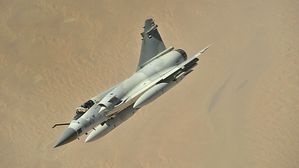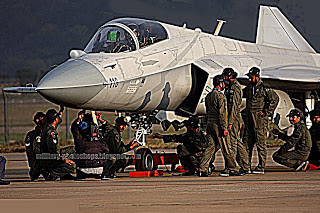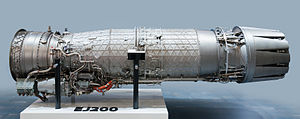ISLAMABAD — News that Egypt may acquire the UAE's Mirage fighters is likely to scupper Pakistan's hopes of selling the JF-17, especially since Cairo is also reportedly negotiating for 20 Rafale fighters, and shown interest in the MiG-35. However, brisk development of the JF-17 continues alongside sales efforts.
Kaiser Tufail, former Pakistani air commodore, said the UAE's offer of an undisclosed number of Dassault-built Mirage 2000-9s to Egypt means the JF-17 may be out of contention in Cairo.
"If [Egypt] purchases Mirage 2000-9s as well as some more of the older refurbished 2000-5s, it would certainly not need the JF-17, which is less capable than the French fighter," he said.

DEFENSENEWS
UAE Offers Mirage Fighters to Iraq
With large numbers of obsolete Mirage 5, MiG-21 and Chengdu J-7 fighters, Egypt was a prime JF-17 target. The JF-17 Thunder is built by China's Chengdu Aircraft Industry Group and Pakistan Aeronautical Complex.
However, analyst Usman Shabbir of the Pakistan Military Consortium think tank believes the JF-17 is a victim of geopolitical circumstances, though Egypt may struggle with the French fighters.
"Considering the current Egyptian economical situation, any purchase of Rafale or Mirages would have to be bankrolled by its Arab allies [Saudi Arabia and the UAE]. Rafale is too expensive to buy and operate even for countries with deeper pockets. Mirages might be gifted or sold at a nominal price, but it is also a very expensive aircraft to operate, and weapons and support are going to be very expensive," he said.
He considers the JF-17 better suited to Egypt's economic, industrial and operational requirements.
"The JF-17 is cheaper to buy and operate and comes with a weapons package that Egypt can't get elsewhere. Also, they have prior experience in dealing with Chinese industry and have developed very a good working relationship with them."
Since 2010, Egypt has been offered local production of the JF-17, having previously built Sino-Pakistani K-8E Karakorum jet trainers for the Egyptian Air Force.
Generally, Tufail believes the JF-17 will struggle against surplus Western aircraft.
"The JF-17 will continue to face a challenge from old NATO F-16s, as well as Mirage-2000s, which are available in the market, albeit subject to end-user clearance from US and France," he said. "I think that the JF-17 has a market only in those African and Asian countries where the nature of the threat does not warrant very expensive and over-endowed warplanes."
Nevertheless, until Egypt makes a decision, the JF-17 team remains hopeful.
Citing client confidentiality, Air Commodore Khalid Mahmood, director of sales and marketing for the JF-17, would not comment on negotiations with the Egyptians, only that negotiations were ongoing with 11 countries.
He stressed that the program is on track.
"The JF-17 program has not stopped. It's moving fast although people may not know it; especially on the Chinese side because new weapons came up like the J-31, the Y-20, and some 3-D radars etc. So, for some people it may be a little out of sight, but the program is progressing at a very fast pace."
"We have not stopped our development while the production is continuing as planned. We're happy with the response of the international community, of friendly nations regarding the induction capability of this aircraft," he said. "We are getting many queries thus far."
He does not believe the JF-17 will be a victim of a divergence in the fighter market with affluent nations opting for high end fighters while others purchase lead-in fighter trainer (LIFT) aircraft.
"Everyone needs a high tech aircraft. Those who can afford it buy them. Others think a LIFT will fill the gap, but it doesn't," he said. "We can offer customers a far more capable aircraft at a similar price. We can offer them support and maintenance. We don't just offer them aircraft. We don't walk away from our responsibilities."
Nor does he believe Russian competition will directly hamper sales.
"In this class of fighter, the Russians don't have any airplanes. The nations which consider the JF-17, the Russians cannot offer an alternative aircraft because the aircraft are big, twin-engined, mostly twin-tailed, and of course they need bigger infrastructure, the storage, everything has to be specialized for those airplanes.
"Nations make their own decisions, but what is the most popular requirement?" he added. "Everybody wants to retain the same infrastructure, without them changing everything; they want to buy an aircraft with similar capabilities."
Presently development is focused on the third variant.
"We are in the process of finalizing the conceptual design of the Block III," he said. "Production is still three years away. Block III will be a big jump. The capabilities will be enhanced with previous ones retained."
Speculation focuses on possible dedicated stations for targeting pods, but Mahmood would say only that this was possible, and highlighted the present practice of using dual ejector racks "to offset this smaller size of the airplane."
Hitherto, those seen on the JF-17 have carried bombs, but there is speculation regarding dual racks designed for SD-10 beyond-visual-range air-to-air missiles being tested.
Considerable improvements have also been made to armament options in the past two years, with emphasis on survivability and multirole capabilities.
"We're presently in the age of standoff weaponry. The Chinese have cleared a number of weapons for export, including long range anti-radiation missiles and [LG6] standoff munition dispensers. The anti-ship missile armament is also quite potent and comprises of the CM-400AKG and C-802AK. Each JF-17 is capable of carrying anti-ship missiles. The software is there. There are no fleets within fleets."
Perhaps reflecting an impending deal, he highlighted 90mm rocket launchers have been fitted at the behest of a potential customer and that such requests are prioritized.
"As a matter of policy we will add anything to the aircraft that will increase its potential, and even consider a Western engine if the customer so desires. We have spoken to suppliers about this, to Rolls-Royce. So if a customer decides we can do it, we can integrate a new engine. It will take a bit of time, but it can be done."
This is believed to be a reference to an EJ200-powered JF-17 targeted at Saudi Arabia, which in early 2014 discussed possible co-production and financing.
المصدر:
http://www.defensenews.com/story/de...5/pakistan-jf-17-china-egypt-mirage/22170455/
Kaiser Tufail, former Pakistani air commodore, said the UAE's offer of an undisclosed number of Dassault-built Mirage 2000-9s to Egypt means the JF-17 may be out of contention in Cairo.
"If [Egypt] purchases Mirage 2000-9s as well as some more of the older refurbished 2000-5s, it would certainly not need the JF-17, which is less capable than the French fighter," he said.

DEFENSENEWS
UAE Offers Mirage Fighters to Iraq
With large numbers of obsolete Mirage 5, MiG-21 and Chengdu J-7 fighters, Egypt was a prime JF-17 target. The JF-17 Thunder is built by China's Chengdu Aircraft Industry Group and Pakistan Aeronautical Complex.
However, analyst Usman Shabbir of the Pakistan Military Consortium think tank believes the JF-17 is a victim of geopolitical circumstances, though Egypt may struggle with the French fighters.
"Considering the current Egyptian economical situation, any purchase of Rafale or Mirages would have to be bankrolled by its Arab allies [Saudi Arabia and the UAE]. Rafale is too expensive to buy and operate even for countries with deeper pockets. Mirages might be gifted or sold at a nominal price, but it is also a very expensive aircraft to operate, and weapons and support are going to be very expensive," he said.
He considers the JF-17 better suited to Egypt's economic, industrial and operational requirements.
"The JF-17 is cheaper to buy and operate and comes with a weapons package that Egypt can't get elsewhere. Also, they have prior experience in dealing with Chinese industry and have developed very a good working relationship with them."
Since 2010, Egypt has been offered local production of the JF-17, having previously built Sino-Pakistani K-8E Karakorum jet trainers for the Egyptian Air Force.
Generally, Tufail believes the JF-17 will struggle against surplus Western aircraft.
"The JF-17 will continue to face a challenge from old NATO F-16s, as well as Mirage-2000s, which are available in the market, albeit subject to end-user clearance from US and France," he said. "I think that the JF-17 has a market only in those African and Asian countries where the nature of the threat does not warrant very expensive and over-endowed warplanes."
Nevertheless, until Egypt makes a decision, the JF-17 team remains hopeful.
Citing client confidentiality, Air Commodore Khalid Mahmood, director of sales and marketing for the JF-17, would not comment on negotiations with the Egyptians, only that negotiations were ongoing with 11 countries.
He stressed that the program is on track.
"The JF-17 program has not stopped. It's moving fast although people may not know it; especially on the Chinese side because new weapons came up like the J-31, the Y-20, and some 3-D radars etc. So, for some people it may be a little out of sight, but the program is progressing at a very fast pace."
"We have not stopped our development while the production is continuing as planned. We're happy with the response of the international community, of friendly nations regarding the induction capability of this aircraft," he said. "We are getting many queries thus far."
He does not believe the JF-17 will be a victim of a divergence in the fighter market with affluent nations opting for high end fighters while others purchase lead-in fighter trainer (LIFT) aircraft.
"Everyone needs a high tech aircraft. Those who can afford it buy them. Others think a LIFT will fill the gap, but it doesn't," he said. "We can offer customers a far more capable aircraft at a similar price. We can offer them support and maintenance. We don't just offer them aircraft. We don't walk away from our responsibilities."
Nor does he believe Russian competition will directly hamper sales.
"In this class of fighter, the Russians don't have any airplanes. The nations which consider the JF-17, the Russians cannot offer an alternative aircraft because the aircraft are big, twin-engined, mostly twin-tailed, and of course they need bigger infrastructure, the storage, everything has to be specialized for those airplanes.
"Nations make their own decisions, but what is the most popular requirement?" he added. "Everybody wants to retain the same infrastructure, without them changing everything; they want to buy an aircraft with similar capabilities."
Presently development is focused on the third variant.
"We are in the process of finalizing the conceptual design of the Block III," he said. "Production is still three years away. Block III will be a big jump. The capabilities will be enhanced with previous ones retained."
Speculation focuses on possible dedicated stations for targeting pods, but Mahmood would say only that this was possible, and highlighted the present practice of using dual ejector racks "to offset this smaller size of the airplane."
Hitherto, those seen on the JF-17 have carried bombs, but there is speculation regarding dual racks designed for SD-10 beyond-visual-range air-to-air missiles being tested.
Considerable improvements have also been made to armament options in the past two years, with emphasis on survivability and multirole capabilities.
"We're presently in the age of standoff weaponry. The Chinese have cleared a number of weapons for export, including long range anti-radiation missiles and [LG6] standoff munition dispensers. The anti-ship missile armament is also quite potent and comprises of the CM-400AKG and C-802AK. Each JF-17 is capable of carrying anti-ship missiles. The software is there. There are no fleets within fleets."
Perhaps reflecting an impending deal, he highlighted 90mm rocket launchers have been fitted at the behest of a potential customer and that such requests are prioritized.
"As a matter of policy we will add anything to the aircraft that will increase its potential, and even consider a Western engine if the customer so desires. We have spoken to suppliers about this, to Rolls-Royce. So if a customer decides we can do it, we can integrate a new engine. It will take a bit of time, but it can be done."
This is believed to be a reference to an EJ200-powered JF-17 targeted at Saudi Arabia, which in early 2014 discussed possible co-production and financing.
المصدر:
http://www.defensenews.com/story/de...5/pakistan-jf-17-china-egypt-mirage/22170455/





